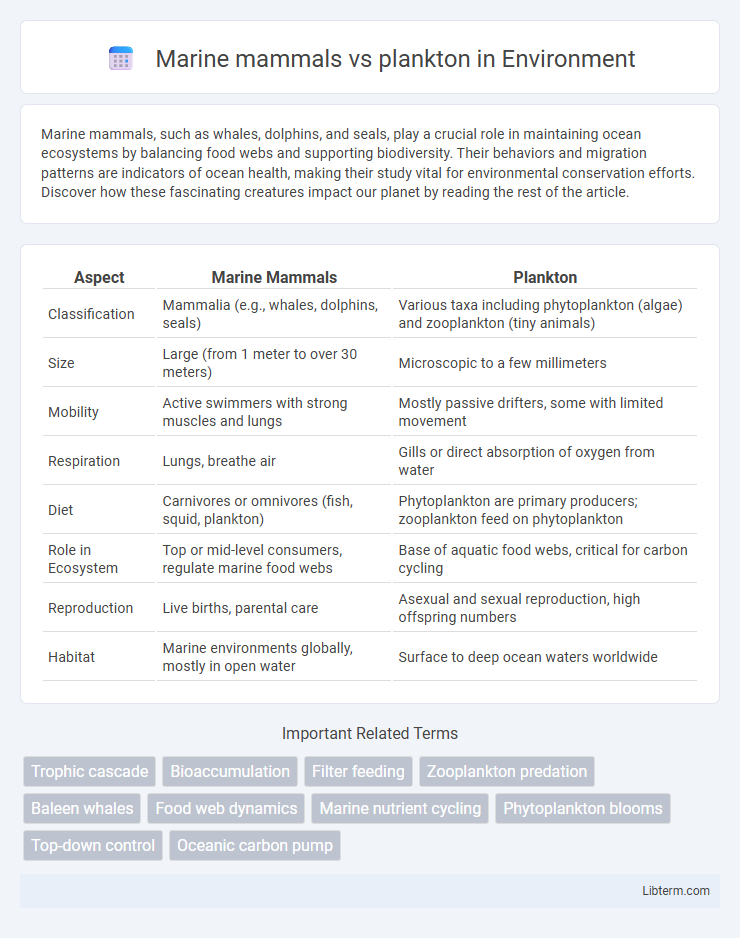Marine mammals, such as whales, dolphins, and seals, play a crucial role in maintaining ocean ecosystems by balancing food webs and supporting biodiversity. Their behaviors and migration patterns are indicators of ocean health, making their study vital for environmental conservation efforts. Discover how these fascinating creatures impact our planet by reading the rest of the article.
Table of Comparison
| Aspect | Marine Mammals | Plankton |
|---|---|---|
| Classification | Mammalia (e.g., whales, dolphins, seals) | Various taxa including phytoplankton (algae) and zooplankton (tiny animals) |
| Size | Large (from 1 meter to over 30 meters) | Microscopic to a few millimeters |
| Mobility | Active swimmers with strong muscles and lungs | Mostly passive drifters, some with limited movement |
| Respiration | Lungs, breathe air | Gills or direct absorption of oxygen from water |
| Diet | Carnivores or omnivores (fish, squid, plankton) | Phytoplankton are primary producers; zooplankton feed on phytoplankton |
| Role in Ecosystem | Top or mid-level consumers, regulate marine food webs | Base of aquatic food webs, critical for carbon cycling |
| Reproduction | Live births, parental care | Asexual and sexual reproduction, high offspring numbers |
| Habitat | Marine environments globally, mostly in open water | Surface to deep ocean waters worldwide |
Introduction to Marine Mammals and Plankton
Marine mammals, including whales, dolphins, and seals, are warm-blooded vertebrates that rely on lungs for breathing and exhibit complex behaviors and advanced sensory capabilities. Plankton, composed primarily of microscopic plants (phytoplankton) and animals (zooplankton), form the foundational base of oceanic food webs through their photosynthetic and consumption activities. The interaction between marine mammals and plankton is a key ecological relationship, with some species of whales directly feeding on large quantities of plankton to sustain their massive energy needs.
Defining Marine Mammals: Key Characteristics
Marine mammals, including whales, dolphins, and seals, are warm-blooded vertebrates characterized by their ability to breathe air through lungs, live in aquatic environments, and bear live young. They possess adaptations such as blubber for insulation, specialized limbs for swimming, and complex social behaviors. Unlike plankton, which are microscopic drifting organisms, marine mammals are large, mobile predators with advanced sensory and cognitive functions.
Understanding Plankton: Types and Roles
Plankton, including phytoplankton and zooplankton, form the foundation of marine ecosystems by serving as the primary producers and essential food source for marine mammals such as whales, seals, and dolphins. Phytoplankton perform photosynthesis, producing oxygen and organic compounds that sustain the marine food web, while zooplankton consume phytoplankton and in turn provide nutrition for larger marine species. Understanding the diversity and ecological roles of plankton highlights their critical influence on marine mammal populations and overall ocean health.
Habitat Comparison: Where They Thrive
Marine mammals predominantly inhabit coastal regions, deep ocean areas, and polar environments, adapting to diverse habitats like coral reefs, estuaries, and open seas. Plankton thrive mostly in the photic zone of oceans and freshwater bodies, relying on sunlight for photosynthesis in the case of phytoplankton, or drifting with currents as zooplankton. While marine mammals actively navigate vast oceanic territories, plankton remain passive drifters, making their distribution highly dependent on water temperature, salinity, and nutrient availability.
Feeding Strategies: Predators vs. Producers
Marine mammals, as apex predators, employ diverse feeding strategies such as filter feeding, hunting, and echolocation to capture fish, squid, and other prey. Plankton, primarily microscopic producers including phytoplankton, rely on photosynthesis to convert sunlight into energy, serving as the foundational producers in marine food webs. This predator-producer dynamic underscores energy transfer from plankton to marine mammals through complex trophic interactions.
Role in Marine Food Webs
Marine mammals occupy the apex of marine food webs, preying on fish, squid, and even plankton, regulating populations and maintaining ecological balance. Plankton serve as the foundational producers and primary consumers in marine ecosystems, converting solar energy into biomass and providing essential nutrients for higher trophic levels. The interaction between marine mammals and plankton highlights the transfer of energy across multiple trophic layers, crucial for sustaining marine biodiversity and ecosystem stability.
Adaptations for Survival
Marine mammals possess adaptations such as thick blubber for insulation, advanced echolocation for hunting, and lungs designed for deep dives, enabling survival in cold, high-pressure ocean environments. Plankton display survival strategies like bioluminescence for predator avoidance, floating structures to maintain buoyancy, and rapid reproductive cycles to sustain populations despite predation. These distinct adaptations allow both marine mammals and plankton to thrive within their respective ecological niches in the marine environment.
Ecological Impact and Interdependence
Marine mammals play a critical role in regulating plankton populations through nutrient cycling and predation, which helps maintain oceanic food web stability. Plankton, including phytoplankton and zooplankton, serve as the foundational producers of marine ecosystems, supporting marine mammal populations indirectly by sustaining fish and other prey species. This interdependence drives ecological balance, influencing carbon sequestration and nutrient distribution across marine environments.
Human Influence on Marine Mammals and Plankton
Human activities profoundly impact marine mammals and plankton through pollution, overfishing, and climate change. Chemical contaminants and plastic debris accumulate in marine mammals, causing health issues, while nutrient runoff and ocean acidification disrupt plankton populations critical for marine food webs. Industrial fishing reduces plankton predators and alters ecosystem balance, threatening biodiversity and fisheries dependent on both groups.
Conservation Challenges and Future Outlook
Marine mammals face escalating conservation challenges due to habitat degradation, climate change, and entanglement in fishing gear, threatening their populations and biodiversity. Plankton, as a foundational component of marine ecosystems, are affected by ocean acidification and warming, impacting food webs and carbon cycling crucial for marine mammals' survival. Future outlook emphasizes integrated conservation strategies combining habitat protection, pollution control, and climate action to ensure the resilience of marine mammals and the plankton populations they rely on.
Marine mammals Infographic

 libterm.com
libterm.com